#I then use the mushrooms to test glaze combinations
Text




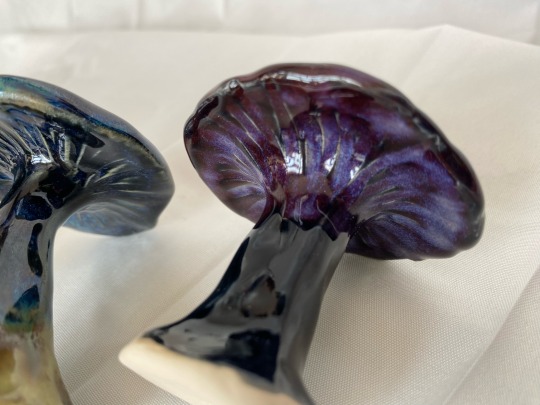


#available#this is what I do with any leftover clay#I turn it into a mushroom#I then use the mushrooms to test glaze combinations#so I end up with some weird shit#but I like them#mushrooms#ceramic#sculpture#pottery#mushroom#lately I've started turning leftover clay into beetles#people seem to like beetles lol#claypigeon
162 notes
·
View notes
Text
Duck Day 2019 Menu and Recipes
Our thanksgiving-day extravaganza is done, and as usual I’m posting a blog entry for posterity and my own reference so I can find these things again if I need them. :-)
We’ve done “Asian fusion” many times–it’s kind of corwin and my culinary wheelhouse–but this is the first time we really incorporated more filipino flavors.
First, the menu:
2019 Duck Day: Tour of the Eastern Rim of the Pacific
(Tokyo, Shanghai, Manila, Palu)
“Sinigang” Amuse
Tomato Dashi & Sake (Kubota Hekijyu junmai daiginjo)
with a dehydrated mushroom chip
powdered shoyu
powdered tamarind
“Pu-Pu Platter” with Scorpion Bowl
Curry puff with curry mayo
Lumpia (traditional filipino fried spring rolls)
Chicken wings with candied ginger and orange
Pickles: honshimeji mushroom, yuzu-pickled napa
Assortment of dipping sauces
“Adobo” served with Sapporo Premium
duck confit adobo style (with soy, vinegar, garlic and ginger)
with a duck-fat crisped potato and
adobo-style vinaigrette tossed peas
topped with crispy garlic
Zhajiang Mian (fried sauce noodle)
homemade chewy wheat noodle with ground duck and bean paste sauce
With shochu oolong hi-ball
Duck a l’kalamansi (filipino bitter orange) with Trimbach Reserve Gewurtzraminer
Rice two ways
Steamed bok choy
and a caramel vinegar gastrique
Palate cleanser
Yuzu sorbet with finger lime caviar, served with Kikusui Perfect Snow unfiltered sake
Dessert
Saikyo miso ice cream
With almond brown butter Sablé cookies
Puffed rice
And hot chocolate
Tea, Coffee, and Mignardise
candied ginger
almond coconut mango-marmalade thumbprint cookies
almond brown-butter-chocolate cookies
Every year there ends up being something we forgot to serve. This year it was the matchstick carrots and cucumber that were supposed to garnish the zhajiang noodle! Ah well.
“Sinigang” Amuse
Tomato Dashi & Sake (Kubota Hekijyu junmai daiginjo)
with a dehydrated mushroom chip
powdered shoyu
powdered tamarind
This dish combines two things. One is the idea of sinigang, which is a filipino tamarind-flavored stew/soup that often has fish, tomato, and onion. The other is the technique of mixing sake with a hot, intense broth to delicious effect. We learned this trick one wet, cold rainy afternoon while out day drinking with a chef friend-of-a-friend in the Akabane area of Tokyo. One of the places he took us was an oden (stewed fishball & tofu) shop where you could buy a one-cup sake. When you drank half your sake, for ten yen you could get them to top up the glass with the oden broth.
corwin made the broth by starting with our home-canned smoked tomato water (already one of the most umami-intense things we have), simmering it with kombu and bonito flakes to make it tomato dashi, and then going over to a friend/s house to borrow his Spinzall (food centrifuge) to clarify it.
For the tamarind flavor we put tamarind powder on the plate for folks to rim their glasses with. We also gave them the soup and the sake separately to mix as they liked. And also some powdered soy sauce we got as a parting gift at one of the fancy restaurants we ate at in Kyoto: Shimogamo Saryo.
View this post on Instagram
Some of the delights of #duckday2019
A post shared by Regis (@rmd1023) on Nov 28, 2019 at 9:49pm PST
“Pu-Pu Platter” with Scorpion Bowl
Curry puff with curry mayo
Lumpia (traditional filipino fried spring rolls)
Chicken wings with candied ginger and orange
Pickles: honshimeji mushroom, yuzu-pickled napa
Assortment of dipping sauces
Curry Puff
corwin made the curry puff (karipap), startingwith making his own curry powder. He didn’t use the karipap recipe in Asian Dumplings but instead used his own biscuit dough recipe and it worked beautifully.
Lumpia
It was my first time making lumpia. Lumpia is one of those foods that was at every filipino party we went to when I was growing up, but my family was never the one that made them. (We brought the pancit or the dessert.) It was traditional for the aunties to complain about what a pain they are to make, though. Well, now I know what they mean, but it is SO WORTH IT.
This is by far the weirdest dumpling skin or wrapper I’ve made yet. Andrea Nguyen’s ASIAN DUMPLINGS is my go-to book–she hasn’t steered me wrong, yet. The technique for making these involved picking up the entire blob of wet dough in your hand and them blopping it onto a slightly hot pan, and the smear you leave on the pan IS THE LUMPIA WRAPPER.
What I learned is if the pan is too hot is that it just sears the ball of dough in your hand but it doesn’t stick to the pan. This is bad. And if the pan isn’t hot enough, then it doesn’t work either. So there is a very narrow window where it works. I had to turn the burner on and off between each one and also dribble a little extra water into the dough before each one. What would work is I would make one, and when the pan was the right heat, the wrapper would release, and this would mean it was now the right heat for the next one to be made. I would turn off the heat, make the next one, let it cool for a few seconds in the pan and then have to heat it back up again to release it and be ready for the next one.
Here’s Andrea Nguyen’s short video on how to do it:
youtube
The filling I used was similar to the recipe in Asian Dumplings, but I replaced the carrot and bean with water chestnuts (and the ground meat was duck). If I do it again I’ll probably use pork and up the intensity of the spices/salt/fish sauce. It could use dried shrimp in the sauce.
Chicken Wings with Candied Ginger and Orange
This was one of those ideas I had one day while we were out and I made a note in my phone months ago: what if instead of just having a chicken wing that was honey-glazed and chewy you could take that to the next level by having actual bits of candied ginger and candied orange rind in the glaze? I tested it last week and was very pleased with the results.
Although I candied my own ginger for the mignardise in this meal, I used some that I had bought at Cambridge Naturals for this recipe, and the candied orange rinds were some fancy artisanal ones corwin picked up at Formaggio. But I think Trader Joe’s or whatever would work just as well.
The first step is oven-frying the chicken wings as detailed by J. Kenji Lopez-Alt at Serious Eats (as in this recipe: https://www.seriouseats.com/recipes/2015/01/hot-and-numbing-oven-fried-xian-chicken-wings-recipe.html)
I ran tests last week where I tried both spicing them with a technique as described in the Serious Eats article (toss the crispy wings in oil and then in a spice mix) and also by tossing them in a glaze. Turned out the way we liked them best was tossed in the spices and THEN dipped in the glaze separately. That was a little impractical for a large dinner party so I settled for brushing them with glaze and then sprinkling the chopped bits of candied ginger and orange rind on them. By not coating them completely in glaze, they retain more crispness.
Glaze:
1 cup orange juice
1 cup water
quarter to half cup yuzu marmalade or other citrus marmalade
quarter to half cup apple cider vinegar
1/8 to quarter cup brown sugar
powdered ginger
minced garlic
I am a little loose on the quantities in the glaze recipe because I think it really depends on how sweet the orange juice is and how sour the vinegar is — you just have to taste it to see if it’s what you want.
View this post on Instagram
Second course: “pu pu platter with scorpion bowl”. I reinvented the chicken wing for this, with candied ginger and orange rind. Curried duck puffs. And fried lumpia with ground duck and shrimp filling (Filipino spring rolls) which are the fiddliest thing I’ve ever made! But damn they came out great! #duckday2019
A post shared by Cecilia Tan (@ctan_writer) on Nov 28, 2019 at 10:18pm PST
“Adobo” served with Sapporo Premium
duck confit adobo style (with soy, vinegar, garlic and ginger)
with a duck-fat crisped potato and
adobo-style vinaigrette tossed peas
topped with crispy garlic
Adobo is a filipino dish that has more variations than there are islands. The common element seems to be the combination of soy, vinegar, and garlic. Some have curry powder, some have ginger, etc. Some stew chicken and pork together, some are just chicken. My family’s adobo was usually chicken, potatoes, and green beans, stewed together in soy and vinegar with garlic (and served over white rice).
To deconstruct it, corwin confit’ed duck legs sous vide with soy-vinegar-garlic-ginger in the bags. Then he shredded the meat and crisped it in cast iron, and served it with an adobo-flavored reduction, topped with crispy garlic. I boiled the potatoes in advance, then crushed them slightly to give them crisp edges roasted in duck fat. The beans in the dish I replaced by making a mix of bias-cut fresh snap peas and fresh snow peas tossed in a soy-vinegar-ginger-garlic vinaigrette.
View this post on Instagram
Deconstructed Filipino adobo. Confit duck with a soy-vinegar reduction and crispy garlic, duck fat crisped potato, and fresh snap pea in adobo-style vinaigrette #duckday2019
A post shared by Cecilia Tan (@ctan_writer) on Nov 28, 2019 at 10:21pm PST
View this post on Instagram
Poultry differently. #duckday2019
A post shared by Liz LaManche (@liz_lamanche) on Nov 29, 2019 at 10:55am PST
Zhajiang Mian (fried sauce noodle)
homemade chewy wheat noodle with ground duck and bean paste sauce
With shochu oolong hi-ball
Normally we do a lot of wine pairings, but a lot of wines just don’t pair with these strong and tangy flavors as well as other alcohols do.
For this one we made Chu-hi, which is the Japanese shochu high ball, using dark pearl oolong tea and a whiskey-like shochu called Gokoo that we first had at Momi Nonmi in Cambridge a couple of weeks ago. (It’s seriously great if you’re a whiskey drinker.)
For the wheat noodle we ended up borrowing a pasta extruding machine from our friends David and Diane. What was funny is when corwin ran our test, he made the dough way too dry, so the noodles came out very rough and odd-looking. But they were so tasty and the chewiness was really good, so we decided to just keep going and use them in the meal.
View this post on Instagram
Noodle extrusion experiment. I think the pasta is too dry….?
A post shared by Cecilia Tan (@ctan_writer) on Nov 25, 2019 at 9:53pm PST
The sauce I sort of improvised on some zhajiang mian recipes but I wanted something somewhat spicier to highlight the duck. (Among the ones I looked at: Woks of Life, China Sichuan Food.)
Sauce:
1 lb. ground meat — let sit in 1 tablespoon corn starch, 1 tsp salt, 1/2 tsp white pepper, 1 tablespoon oil 15 minutes before starting
6 slices ginger, minced
6 cloves garlic, minced
6-10 fresh shiitake, chopped/minced
1/4 cup sweet bean paste
1/4 to 1/2 cup ground bean paste
1 tablespoon chili bean paste
1/3 cup dark soy sauce
1 cup water
Soften the ginger and garlic in the oil and then brown the meat. Add the mushrooms after a minute or two, and once the meat is no longer pink, add all the wet ingredients and stir together to combine. Let simmer 15 minutes. Then add 1/2 cup water with 1 TBS cornstarch dissolved in it to thicken. If still too thin, simmer 5 more minutes.
View this post on Instagram
Zhajiang “fried sauce” noodles – homemade thick wheat noodle with ground duck and bean paste sauce. So happy with how this came out! #duckday2019
A post shared by Cecilia Tan (@ctan_writer) on Nov 28, 2019 at 10:24pm PST
This was the dish where I forgot the garnish! I have all these matchstick cut carrots and cucumber and I forgot entirely to put them on the plate! There’s always SOMETHING that gets left off.
Duck a l’kalamansi (filipino bitter orange) with Trimbach Reserve Gewurtzraminer
Rice two ways
Steamed bok choy
and a caramel vinegar gastrique
This is basically duck a l’orange, which we’ve never done in all these years of making duck. Typically this comes out too sweet because people use regular oranges instead of bitter oranges. corwin ordered a bunch of kalamansi (filipino bitter orange) online, though, when he was getting our now-nnual yuzu order. This is also when he picked up the finger limes for the palate cleanser.
View this post on Instagram
Duck a l’orange done Peking style with calamansi oranges for a Filipino touch. #duckday2019
A post shared by Cecilia Tan (@ctan_writer) on Nov 28, 2019 at 10:25pm PST
View this post on Instagram
Yin yang rice. One of the elements of one of the courses. #duckday2019
A post shared by Cecilia Tan (@ctan_writer) on Nov 28, 2019 at 10:03pm PST
Palate cleanser
Yuzu sorbet with finger lime caviar, served with Kikusui Perfect Snow unfiltered sake
View this post on Instagram
Palate cleanser! Yuzu slush with Australian finger lime caviar! And an unfiltered sake

#duckday2019
A post shared by Cecilia Tan (@ctan_writer) on Nov 28, 2019 at 10:28pm PST
Dessert
Saikyo miso ice cream
With almond brown butter Sablé cookies
Puffed rice
And hot chocolate
This dessert was inspired directly by Chris Chung at Momi Nonmi, who serves a saikyo miso ice cream regularly and damn, it’s good. Saikyo is a sweet miso, but it’s also salty, and the result is sort of like a butterscotch or salted caramel flavor. corwin made the ice cream and I made the almond brown butter sable cookies, and crisped the rice.
The crispy rice topping was probably the most work. You have to cook it three times: first you just cook the rice. Then spread it in pan and bake it until it’s dry (around 45 minutes at 250 degrees, IIRC), and then you deep fry it in small batches and spread on paper towels to dry. It kept crispy in an air tight container with some silica gel packs for a few days just fine.
The brown butter sables took some experimenting but I settled on was not only incorporating brown butter into the sable dough, but brushing the tops of the cookies before baking. Otherwise the brown butter flavor was too subtle. I made these by rolling a quarter of the dough into a log shape, letting it chill, and then slicing the log into circles.
I then used the other quarter dough to make these almond chocolate mignardise. (And the other half is still in the fridge waiting for me to do something with…)
View this post on Instagram
Inventing cookie recipes when I can’t find the exact thing I’m imagining. #duckday2019
A post shared by Cecilia Tan (@ctan_writer) on Nov 26, 2019 at 7:32pm PST
Tea, Coffee, and Mignardise
candied ginger
almond coconut mango-marmalade thumbprint cookies
almond brown-butter-chocolate cookies
Candied ginger: I used Alton Brown’s recipe. If I do it again I’ll cut the ginger thicker.
Almond coconut mango-marmalade thumbprint cookies (GLUTEN FREE!)
— I based these on this recipe by Texan Erin: https://ift.tt/34ySMcx
Using the Trader Joe’s Virgin Coconut Oil gives them a really strong coconut flavor and scent.
I made the mango marmalade by taking yuzu marmalade we already had, and a mango that corwin’s mother mailed us from her yard in Florida that we had in the freezer (she sends a whole box and we don’t always get to eating them all before they start to go too soft). The frozen mango flesh doesn’t even need to be pureed — it’s basically mush — so I just cooked it down with the marmalade and a little extra sugar to combine them and thicken up.
These stay soft. They might have been slightly crisp at the edges right from the oven but they soften as they sit. Still delicious.
That’s all I can think of! Now I can close all my recipe tabs!
from cecilia tan https://ift.tt/2q3BVzo
via IFTTT
1 note
·
View note
Text
Where have you booked for Dine Out this year? If you are still deciding, I’m going to start sharing my experiences, whether it’s an invited dinner or out of my own pocket. I was invited as a media to preview the menu at PiDGiN. Their food is a fusion of Asian and French cuisines, and they decorate the interior by rotating artworks by local artists.

They have designed their $45 DOVF menu to be as close to their regular prix fixe menu as possible, which is a 6-course menu shared family style for a minimum of 2 people. You have the option of a omnivore menu, or a vegetarian one. You can also order drink pairing for an additional $40-50 per person. The Dine Out website didn’t include the vegetarian menu, so I suggest you to visit PiDGiN’s website for the menus, and I’m posting them here as well. Note that the following plates are all meant to be shared by 2 people – they will adjust the portion based on party size.
Food
In addition to the 6-course menu, you can also order snacks a la carte. The Beef Tendon Chicharron was addictive. It’s crispy, and it wasn’t greasy. There was just enough seasoning, and the gochugaru citrus spice reminded me of sour plum flavour, with the tiniest hint of heat.

They use different vegetables to make their Daily Pickles. On this day, it was cucumber, ume-infused daikon and shitake mushrooms. They were just slightly pickled, so they weren’t overly briny or vinegary.
Before we started with the first course, we also cheered each other with an Oyster Shot. I liked the addition of celery lime granité, which not only brought flavours, but also a refreshing note. This was a cleaner, lighter version than the typical tomato-based oyster shot.
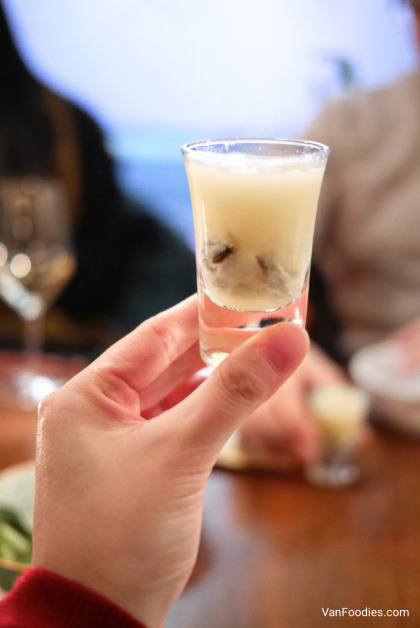
Moving into the six courses. First, I could smell the delicious scent of Brussel Sprouts as soon as I stepped foot into the restaurant. You can never miss the smell of fried brussel sprouts. I was worried that the miso would be too strong and salty, but it was just right. The pickled turnips, to my surprise, was more sweet than sour. Having a little bit of everything to form the “perfect bite”, it was a good balance of sweet and savoury.

This was paired with the Masseria Li Veli, Fiano 2018. It’s quite aromatic, citrusy and easy drinking. It helps cut through the grease in the brussel sprouts.
The next course is different between omnivore and vegetarian. The Tuna Tartare was my favourite of the two. It’s more complex in flavour and texture, with the additional pickled napa cabbage that wasn’t on the beet tartare. There seemed to be more going on in the tuna tartare than the beet one.

I’m a big fan of beets, so I was quite looking forward to the Beet Tartare. By looks, it was on point. It looked like a beef tartare. However I thought it’s a bit one note in flavour and texture. The marinade of the beet was a bit too strong for my liking, so it’s taking away the delicate flavour of the beet. Both tartares were served with crispy lotus chips, and they were so good. Great complement to the tartare.

The tartare course is paired with one of PiDGiN’s pre-batched cocktails, Park Meadows. It has gin, juniper syrup, yuzu and sage. It’s fruity yet herbaceous, with lots of citrusy note. I’m usually not a fan of gin but I would order this again. It comes in a little bottle and a key as bottle opener. Each bottle’s label showcases a different artwork by artists whom have been featured inside the restaurant. This little bottle serves two.
Next, the Cultivated Mushrooms use baby king oyster mushrooms and oyster mushrooms. The highlight for me was the ramen egg – the yolk was in just the right consistency, and the marinade was a perfect sweet-soy combination. While the baby king oyster mushrooms were tasty, the oyster mushrooms were too salty. The truffle celeriac puree was creamy and fragrant, exactly what you would expect from a truffle puree.

PiDGiN is known for its extensive list of sake on the menu. For the mushroom course, they pair it with the Tengumai Yamahai. Interestingly, it has an earthy, mushroomy note on the nose. At first sip, there’s actually a savoury flavour to it. It’s not my favourite sake, but it certainly went well with the dish.

The fourth course also serves up different dishes for omnivore and vegetarian. For omnivore, it’s the Seafood Dashi with sablefish (the website says halibut but it’s sablefish) and side stripe prawns. The sablefish was so good; silky, buttery, flavourful. We had to share the plate among 4 people and I don’t think I had enough. The side stripe prawns were also cooked well – you can still taste the sweetness in the prawns. Another positive in this dish was the mashed potato. It was rich and creamy; and it thickened the broth just a little.

The Vegetable Oden was also very good. There was an abundance of tofu, cabbage, squash, enoki, wakame, potato and daikon. It’s a hearty bowl of vegetables and felt very much like comfort food. The shoyu-based (soy sauce) dashi broth in both dishes were very good. Given we just had our first snow, it’s perfect for this weather.
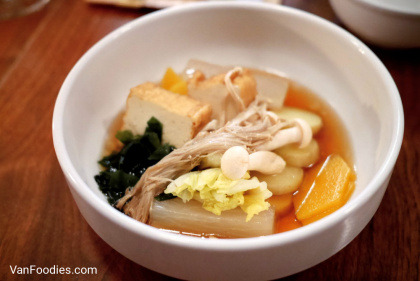
This course was also paired with a sake. The Taiheizan Kimoto. It’s more floral, smoother and sweeter on the palate. I don’t know much about sake, but personally I prefer this one.
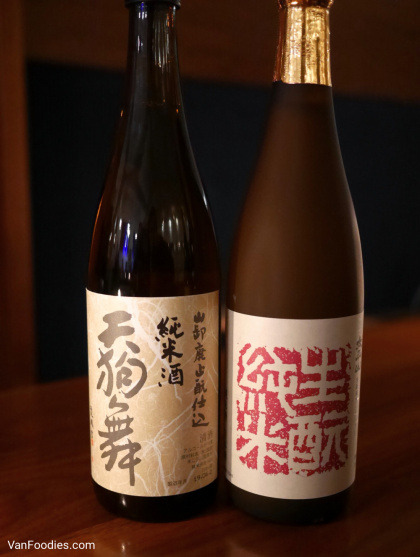
The last savoury course also brought two different dishes. I was quite excited about the Magret Duck Breast. It was tender and cooked perfectly — well seared on the outside and still pink inside. The use of five spice and hoisin glaze added asian flare, so did the Chinese radish cake on the side. My mom makes some great Chinese radish cake for Chinese New Year, with lots of Chinese sausage and daikon prominently in every bite, so I do have pretty high standard for radish cakes. Unfortunately, our piece here was just a bit too salty.

Being red meat, the duck breast is paired with the Origine small-batch Cab Sauv/Merlot/Cab Franc 2017. It’s fruity, well rounded, full body, but doesn’t have a lot of tannin. I quite enjoyed this wine with the duck.
The Carnaroli Risotto demonstrated the precision in the PiDGiN’s kitchen. How they’re going to manage a perfect risotto on every plate would be the ultimate test for them. The rice was cooked well, it was creamy. It’s nice to see sunchokes prepared two ways here. My mother-in-law grows a lot of sunchokes in her garden, so I really enjoyed its earthy flavour, and it paired well with the risotto. The sunchoke chips also added crunchy texture. I especially liked the spruce tip oil, which added some freshness and herbaceous note to the otherwise heavy dish.
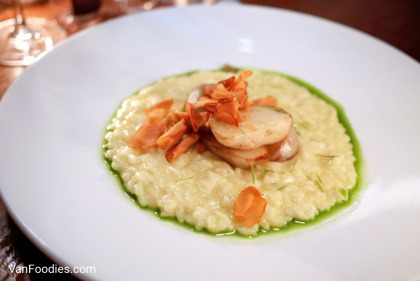
On the contrary, and thankfully, this isn’t paired with the same red wine as the duck breast. This goes with the Nk’mip Chardonnay 2017.
Lastly, the dessert course. The Yuzu Crème Brulee was a great ending to our meal. Lots of citrusy flavour from the yuzu and just the right amount of sweetness. I loved the creamy texture, and the brulee gave the perfect crack on the spoon. Castelvetrano olive is Mr.’s favourite olive, but I’m not sure about its place in desserts. While I like the idea of sweet and savoury together, the candied olive pieces were a bit too briny for my taste.
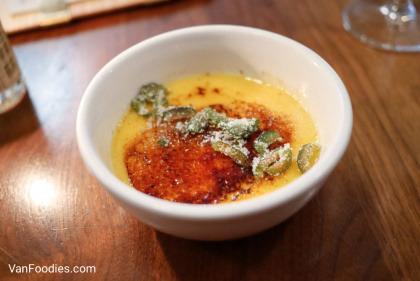
With the dessert course, the Toffee Coffee should be a dessert on its own. It is a miso salted caramel espresso martini. It’s delicious, creamy and rich, and the salt level was just right. A good night cap.

Final Thoughts
Overall, I think PiDGiN’s menu is solid and of great value for $45 per person. Some are hit and miss, but they are minor things that can be adjusted easily. Given that the menu stays true to their regular offering, Dine Out does serve as a good opportunity for you to experience what PiDGiN has to offer. Being a meat eater, I can see myself enjoy the vegetarian menu just as much.

PiDGiN
350 Carrall Street, Vancouver
604-620-9400
pidginyvr.com

[Dine Out Vancouver 2020] PiDGiN: 6-course menu shared family style #DOVF Where have you booked for Dine Out this year? If you are still deciding, I'm going to start sharing my experiences, whether it's an invited dinner or out of my own pocket.
#Beet Tartare#Brussel Sprouts#Creme Brulee#Dashi#Dine Out Vancouver#Dine Out Vancouver 2020#duck breast#mushrooms#Oden#PiDGiN#Risotto#Tuna Tartare
0 notes
Text
Basic Japanese Cuisine: Week 2
Week two started with a little review from week one. We repeated our nimono and mishimono day so we could try it again, and perhaps improve on the dishes from the Friday before. We learned more in depth about simmered and steamed dishes. For example, for nimono (simmered dishes) there are two main categories; one where everything is cooked in the same pot, like nikujaga, and takiawasei - where everything is cooked separately and brought together at the end. We learned that in a restaurant the nimono person has to be one of the most skilled workers. This is because each day they must check that the dashi is consistently perfect, as well as they must find the best possible produce each day, and they must account for the difference in quality and make the proper adjustments. Other variables that the nimono person may have to take into account may be the size or type of the pot and the type of heat source they are using. In mishumono, or steamed dishes, there is no flavored liquid such as dashi, to cook the ingredients; rather it is cooked with only steam. There are a lot of variables you must consider when making a steamed dish. Here, you cant remove any impurities in the middle of the process, you cannot season as you cook- no adding or removing flavors, and you should only use ingredients that can handle the steam- such as avoiding pungent fish and some vegetables. That day we remade chowmushi, but this time it included more chicken and shrimp, and was in a different shape bowl. We also made grilled eel (Unagi hasu mushi) which was steamed after it was grilled. To steam it, we made a combination of grated lotus root, mushroom and whipped to soft peak eggs. We coated the top of the eel in the bowl and it gave a mountain like appearance. With this was ‘bekkou an’ a thickened sauce made from flavored dashi. In addition we remade nikujaga which came out better this time because we did it much closer to eating, so this time it was extremely hot.
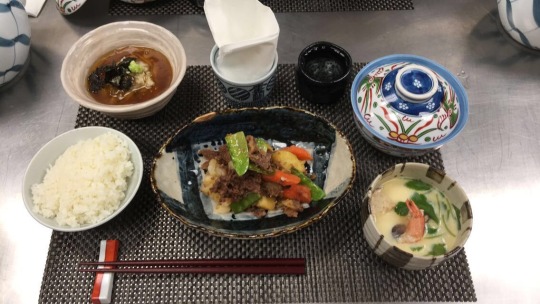
Day seven was a day where we real immersed ourselves in learning to make sashimi. We learned the ways to tell the best quality fish (such as eye color and clarity, how tight the scales hold to the body, the feel and firmness of the flesh, and the gill color- vibrant vs not), the types of fish that degrade the fastest, and the fact that some fish such as tuna need time for the muscles inside of them to relax so the mouth feel is better when eating.

Sensei showed us the fabrication of seabream, mackerel, porgy, and flounder.


Sensei discussed to pair the whiter fleshed fish with a lighter ponzu sauce, while pairing fattier fish with a darker soy sauce. With all of our fish we cut the sashimi. This time we had some experience, so we were able to cut the fish in sashimi pieces much better. To accompany our sashimi, Chef Martin made us a tofu dish with a flavored dashi sauce, ginger, and scallion.
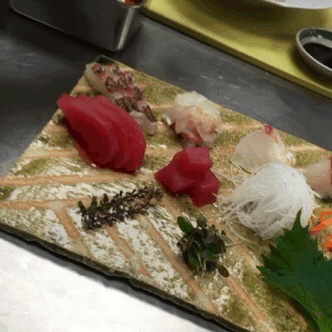
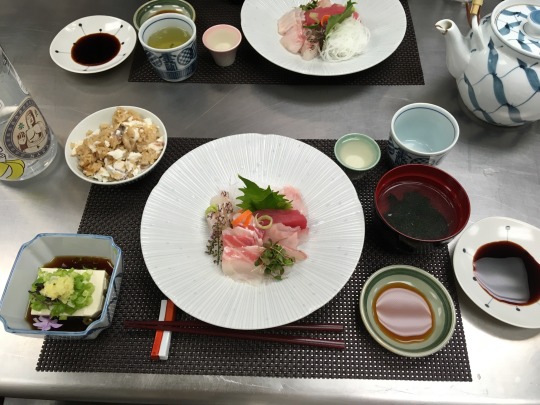
Day eight was yakimono aka grilled foods day. We used a grill box in order to cook our fish. We would skewer the fish so it was in a wave- like form, and we would cook it to get the beautiful dark grill marks, then add a glaze, and cook more to get the glaze locked on to the fish.
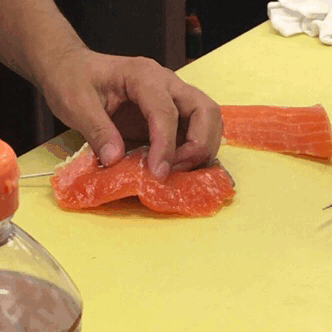
We made another dish with chicken and spinach that was coated in a tahini and tofu thick dressing. We also made a nanban tsuke dish with fried horse mackerel. The special thing about this dish was that we cooked the vegetables in a pan with a hard sear just to get the flavor that comes from the vegetable after that process while we didn’t fully cook the vegetable. The vegetable was put in a vinegared dashi along with the fried fish. It was curious to me that we put the fried fish in the sauce because it would lose the crispiness, but that was not the point- we wanted the flavors that would come with the frying process. The fish that night was excellent and extremely flavorful. I loved the flavor and crispness that came from the open grill. With the fish we plated leaves that beautifully represented fall.

Day nine was very similar to the day before because most of it was a repeat in the process wo we could better learn the techniques. In the lecture we learned more about yakimono and the different types of heat that one could use to cook yakimono. The direct heat methods include charcoal, gas, and electric, and all have their pros and cons. We also learned the main categories of grilled foods which include shioyaki (salt grilled), yuanyaki (marinated), teriyaki (glazed), misodengaku (miso topped/ based), and keshoyaki (layering and grilling with different sauces). We learned about salting fish and its importance. When fish orders come in it is typical to immediately break them down into their fillets so they can last longer. The extra step is to salt them for at least 30 minutes, rinse it off, and dry the fish before storing it. This process is done to improve flavor, to draw out moisture, firm the flesh, and to take out the fishy taste/ aromas. It was very fascinating to learn that most American chefs don’t even know to do this process, while it is critical in Japan. We repeated the nanban tsuke, the chicken and spinach salad, as well as our yakimono fishes. In addition we learned tamogoyaki which is the Japanese rolled omelet. Sensei showed us the proper heating and greasing of the pan. He flipped the eggs so perfectly that when he cut into it the all of the lines were even.
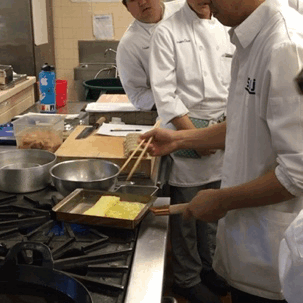
That accompanied our meal with everything else from yesterday’s meal. I was surprised that mine came out quite alright.
Day ten was Friday, aka tempura day. Today we made the tempura and plated it rather than frying it and eating it one at a time like we had in Tokyo. We did it this way because this day was more focused on learning the technique and the following Tuesday would be putting our skills to the test. We first learned to cut the ingredients. Shrimp specifically was different because we pealed the shrimps up to the tail, deveined, scored the belly side, then flipped it over and massaged the tendons on the side. This was all done so that when we fried the shrimp it didn’t want to go to its original form. In addition to shrimp we had anago, lotus root and, shiso leaves. We learned about the importance of the batter and how to make it right. This type of batter had a tendency to get over worked, so it was important to be constantly switching it out for new ones when we saw the quality decrease. It is important to make the batter with low gluten, so we used a mix of cake flour and tempura flour. When mixing together the batter it was important to use large chopsticks as a way to not over mix it. We also only mixed it halfway until homogenous. We were able to monitor the quality of the batter by the way it acted when it touched the hot oil. It the batter stayed in a little dumpling drop when a little was dropped in then we needed to switch it out, but if the batter frayed when it touched the oil, it was just right. We also learned how to monitor the proper oil temperature and maintain it. The optimal temperature range is 338 degrees F to 347 degrees F. The way we could tell the temperature was by dropping in some of the batter with the chop sticks. At 300 degrees the batter would stay on the bottom of the vessel for a few seconds, the batter would hit the bottom but just so quick it would pop up when the oil is at 320. At our optimal range, the batter would drop down only half way the depth of the vessel and come right back to the surface. At 355 degrees F or above, the batter would hit the surface and disperse. When dropping the ingredients into the batter and into the fryer we would use long wooden chopsticks, then to fish them out we would use long metal chopsticks; this was a way to keep them clean. In addition to the individual ingredients, we made kakiage which was many ingredients such as onion slices, cubed scallops, asparagus, and green beans- mixed with the batter and kept into a cake. This would go on top of rice with a flavored dashi sauce on top. The kakiage was my absolute favorite because it was so flavorful and it perfectly matched with the rice.

0 notes
Text
Unpinned - Roasted Kohlrabi and Roasted Delicata Squash
Well, it seems these posts are going to be monthly instead of weekly. Although as the weather gets colder and the days get shorter/darker, I tend to start to hibernate - which means more cooking at home. Actually, I’ve been cooking a lot lately, just nothing new. Until NOW. Because baby our STOVE IS FIXED! After absolutely ruining an entire roast chicken (seriously, how do you mess up a chicken? Put in stove, heat until not-raw) I realized I was waiting 40-50 minutes for my oven to pre-heat and maybe that wasn’t normal? Lo and behold, the heating element in my stove was on the fritz. Now that it’s working I’m cooking up a STORM! Which leads me to today’s adventure: side dishes.

“But Rew!” (you may shout), “who cares about side dishes?” Me. I do. I love a good side dish. Especially if it’s warm and comforting and autumnal and has cheese. In fact, I love them so much that I pretty much just ate side dishes for dinner this night and I have NO REGRETS.

So confession time: I sort of broke my own rules on this one. I know the whole premise of this blog is to test out picture-perfect Pinterest recipes and see if they’re any good, but not this time. This time we worked in reverse. At my local farmer’s market I found not one but TWO vegetables I’d never tasted, and decided to just take them home and hope for the best. I went hunting for recipes and once I found them I plopped them into my Pinterest board. So they’re...technically there. But...only...recently. It’s fine, just go with it. May I present: roasted kohlrabi and roasted delicata squash!
Verdict:
Is the Pintrest photo complete bullshit? - Let’s be honest, that kohlrabi one looks pretty legit to me. The delicata squash is a bit too pristine to be real though.
Is it crazy expensive/time consuming/confusing? - Not at all, once you get over the confusion of trying to understand a kohlrabi itself. Is it a dragon egg? A mushroom? WHO KNOWS?!
Does it taste good? - Both of these are SO good I’ve made them twice this week!! New normal rotation dishes, as long as I can find them! I fear once the farmer’s market closes up shop for the season it’ll be another year until I can get my hands on either :/
Roasted Kohlrabi
Ingredients
4 kohlrabi bulbs, peeled
1 tablespoon olive oil
1 clove garlic, minced
salt and pepper to taste
1/3 cup grated Parmesan cheese
Directions
Preheat an oven to 450 degrees F (230 degrees C).
Cut the kohlrabi into 1/4 inch thick slices, then cut each of the slices in half. Combine olive oil, garlic, salt and pepper in a large bowl. Toss kohlrabi slices in the olive oil mixture to coat. Spread kohlrabi in a single layer on a baking sheet.
Bake in the preheated oven until browned, 15 to 20 minutes, stirring occasionally in order to brown evenly. Remove from oven and sprinkle with Parmesan cheese. Return to the oven to allow the Parmesan cheese to brown, about 5 minutes. Serve immediately.
Roasted Delicata Squash & Onions
Ingredients
2 pounds delicata squash (about 2 large)
1 medium red onion, sliced
2 tablespoons extra-virgin olive oil, divided
¼ teaspoon salt
1 teaspoon chopped fresh rosemary
1 tablespoon maple syrup
1 tablespoon Dijon mustard
Directions
Preheat oven to 425°F.
Cut squash in half lengthwise, then crosswise; scoop out the seeds. Cut lengthwise into ½-inch-thick wedges. Toss with onion, 1 tablespoon oil and salt in a large bowl. Spread in an even layer on a baking sheet.
Roast, stirring once or twice, until tender and beginning to brown, about 30 minutes.
Combine the remaining 1 tablespoon oil, rosemary, syrup and mustard in a small bowl. Toss the vegetables with the dressing.
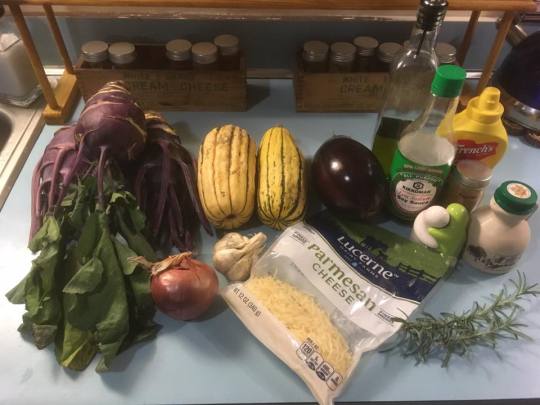
Confession #2: This is more than you will need for these two recipes. Because originally, I was going to attempt three. And then I got tired. And bored. So YOU ONLY GET TWO. I’m sorry, you can just toss that soy sauce, paprika, and eggplant right in the trash.

Since I cheated and found both recipes via Google, I’ll just link you to their Pinterest counterparts here and here. But now that we’ve gotten that out of the way, first: examine your kohlrabi. Seriously. Where do you even start with these things?! What part do you eat!?

First step: although you can eat the leaves (and they’re supposed to be great cooked like collard greens or in a soup), I opted to chop them off and throw them in my stock bag (more on that later).

Realize you’re gonna be at this for a while so go pour yourself a glass of red wine a la Julia Child and laugh at your new bar art. It’s a vintage whiskey advertisement with the STUPIDEST HAPPY LITTLE BIRDS EVER! Seriously, look at their stupid little happy faces. They make me laugh every time I look at them. Shout out to Nate and Miriam for hosting us in Seattle this summer, where I found this!

Ok back to work. You “peel” the kohlrabi the same way you would most any root vegetable. Just...carefully slice all the thick skin off. The ends of the “meat” are kind of tough and woody, so cut those off too. It feels a lot like trying to handle a pineapple.

Looking good! Slice ‘em like fries! Fun fact: kohlrabi is sort of like...if cauliflower and a potato and broccoli and cabbage all had a sort of sweet-tasting baby. I was told multiple times at the market that it’s awesome in coleslaw, and so I snuck a taste of the raw stuff and DANG it was tasty! I ended up eating a whole handful at this point.

Recipe wants you to mix olive oil and garlic in a bowl and then toss in the bowl. Pfft. Yeah. Like I’m gonna dirty another bowl. Not. Mix that shiznit with your hands on the pan.

Ok squash time! The little tag on the delicata squash at the farmers market said it was a popular choice due to its tasty and edible skin - so wait, I don’t need to peel the damn things? Sign me up!

Chop off the ends and scoop out the seeds, so they’re nice and empty - like how you feel after paying your student loan interest :D

CHOP ‘EM! Chop red onions too! Cry into your red wine a little! Salt! Pepper! Olive oil again!!

Here we are getting back to our poor-chef basics: the recipe calls for tasty Dijon mustard. You only have French’s yellow. OH WELL! Use it! We are fancy enough to have wandered outside in the rain to get a sprig of rosemary from our quickly dying garden, so there’s that.

Our squash “dressing”. It only makes a tiny bit but it’s strong, so you just need to mix the squash in the bowl to give it this surprisingly nice little kick. Who’d have thought that rosemary, maple syrup, olive oil and YELLOW MUSTARD would mix up so tasty?

On a side note, my bag of scraps for stock making has NEVER looked so colorful and pretty!

Squash is done! Kohlrabi needed a little extra time. Pro-tip: when making these two recipes at the same time, just pre-heat your (working!) oven to about 440 and keep an eye on them, they’ll cook just fine. Throw your squash into the dressing bowl and mix and mix until everything is nice and slightly smushed/syrupy!
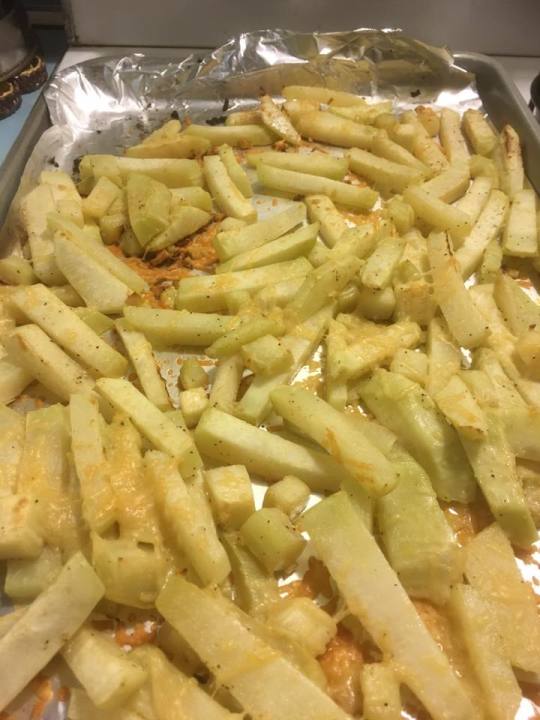
Kohlrabi is nearly done! Sprinkle a handful of Parmesan on top and put it back in the oven for another few minutes. On writing up this review I think I could’ve left them in even longer for more of that nice brown crisping I see in the original recipe. Hmm.
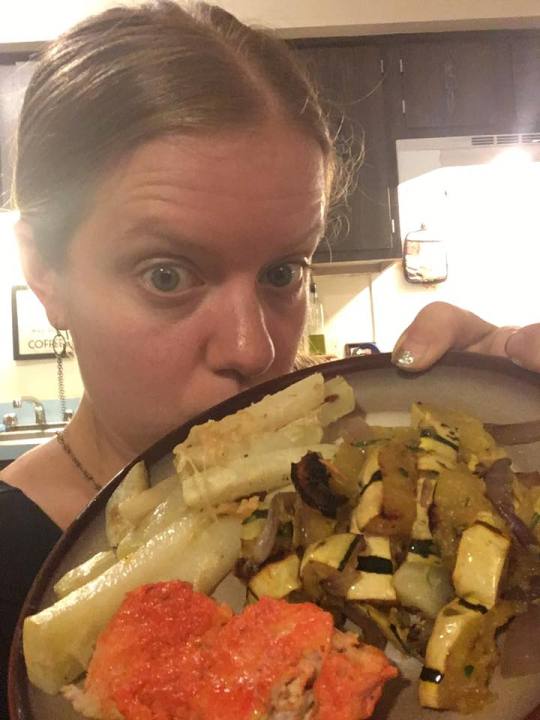
BAM! Dinner is served! Roasted delicata squash with a maple/mustard glaze and Parmesan-roasted kohlrabi, with a tiny side of orange-pink turkey.
Final final verdict: YES! I’m going to make both of these as often as I can while I can find the two elusive veggies!
1 note
·
View note
Text
17 of the Easiest Dinners on 101 Cookbooks
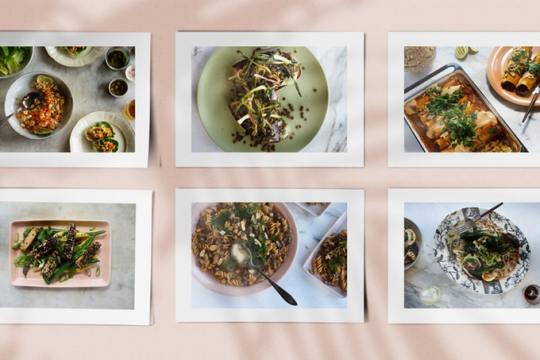
A collection of the easiest dinners on 101 Cookbooks. These are some of my personal favorites - the ones that are super weeknight-friendly, with reasonable ingredient lists. And I'm pulling some long-time favorites from deep in the archives. I'll update and add to it over time with bonus recipes. Enjoy!
1. Pasta with Baby Kale, Toasted Pumpkin Seeds, and Pesto -
Literally, just six ingredients in this awesome pasta bowl. Get the recipe here.

2. Golden-crusted Sesame Seeded Tofu -
In the April 1998 issue of Martha Stewart Living magazine there was a recipe for Sesame Asparagus and Tofu. I ripped it out, and cooked it a hundred times in the twenty years since. Get the recipe here.

3. Spicy Tahini Noodles with Roasted Vegetables -
This is my favorite kind of weeknight meal. Noodles tossed with a quick sauce, topped with an abundance of vegetables, and kissed with chile feistiness courtesy of the condiment shelf. Get the recipe here.
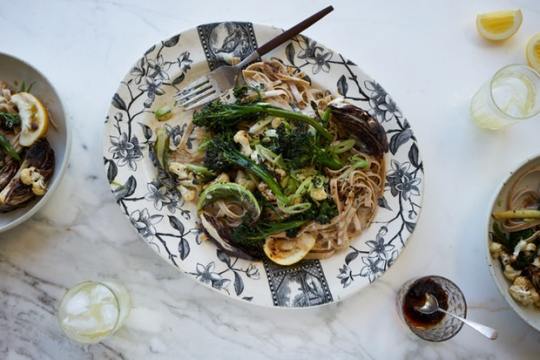
4. Instant Pot Mushroom Stroganoff with Vodka -
My most popular Instant Pot recipe. Make this stroganoff your dinner tonight, seriously! Made with caraway-spiked vodka, and a hearty mushroom base, you get all of what you love about mushroom stroganoff, without the all the butter and cream. Get the recipe here.

5. Mushroom Scallion Tartine with Poblano Yogurt -
A substantial, delicious, mushroom sheet pan sandwich recipe. You roast a bunch of mushrooms and scallions in a hot oven, whip up a simple poblano yogurt while those are roasting. So good! Get the recipe here.

6. Last Minute Red Lasagna -
This is a true weeknight lasagna. No pre-cooking sauces, no pre-cooking noodles. You, literally, stir the first five ingredients together into a vibrant crushed tomato sauce, and start layering. Get the recipe here.

7. Quick Vegan Enchiladas with Sweet Potato Sauce -
Knock-out delicious, you'll have these in the oven in less that ten minutes, They're also a healthful alternative to all the heavy cheese versions out there. With black beans, sweet potatoes, and a stealthy turmeric boost. Get the recipe here.

8. Garlic Lime Lettuce Wraps -
I love these! Ginger and garlic tempeh rice, folded into lime-spiked lettuce wraps with lots of herbs, cucumber, and carrots. A one-pan meal that comes together in no time! Get the recipe here.
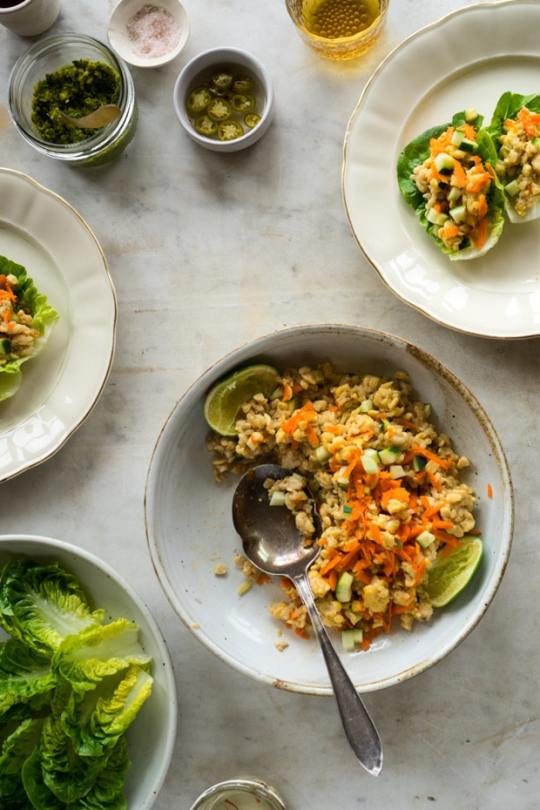
9. Hazelnut Chard Ravioli Salad -
Plump raviolis tossed with toasted hazelnuts, lemony chard, and caramelized onions are at the heart of this ravioli salad recipe. The colorful platter is finished off with a dusting of cheese, snipped chives, and lemon zest. You can prepare most of the components ahead of time. Get the recipe here.
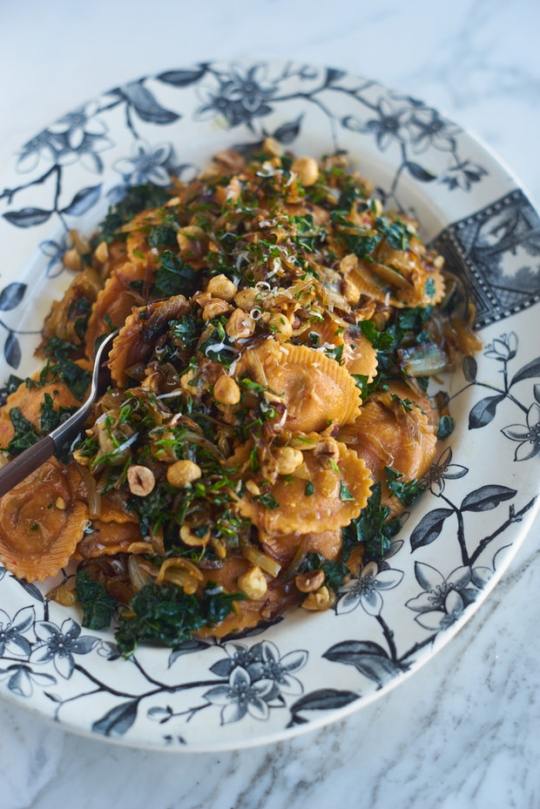
10. Ultimate Vegan Nachos -
When you need a nacho fix, this is how you should roll. At least once. Nachos are always a crowd pleaser, and this is no exception. Oozy, cheesy, loaded vegan nachos everyone loves. Get the recipe here.
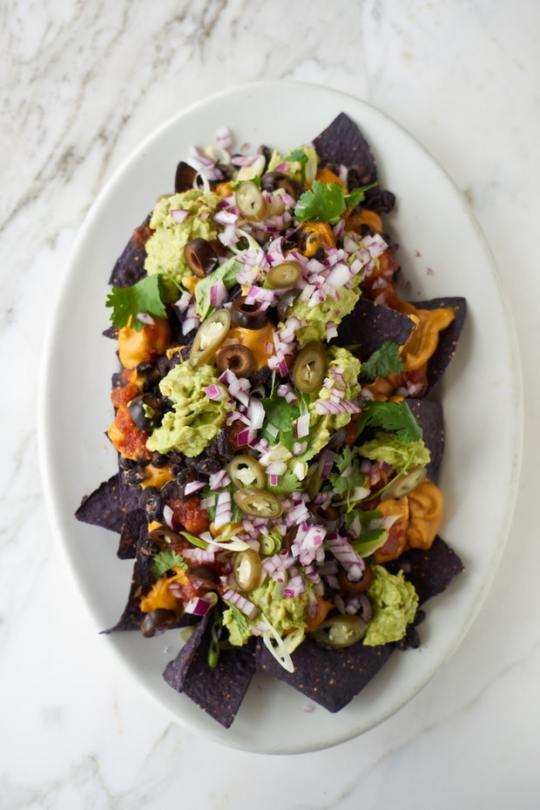
11. Harissa Spaghettini -
I link to this whenever possible. Eight ingredients - most of which you definitely have on hand, between you and this flavor-punched tangle of kale-flecked goodness. That harissa in your refrigerator? This needs to be its destiny. Get the recipe here.
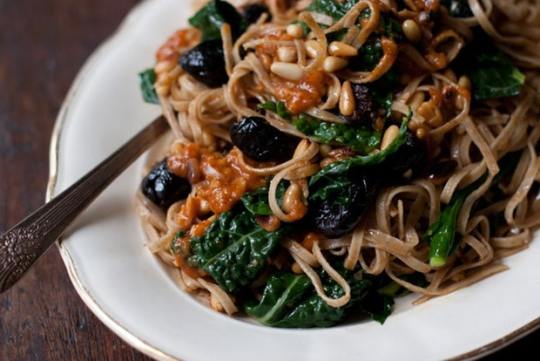
12. Classic Stuffed Shells -
Everyone loves these. The best part about stuffed shells is that you can prepare them days ahead of time. These are topped with red sauce, and filled with ricotta. Crowd pleaser for kids & adults. Get the recipe here.

13. Weeknight Ponzu Pasta -
This is the pasta preparation to make when you want to keep it light, clean, and healthy. Lots of bright green broccoli, green beans, garlic, and pasta tossed with a simple ponzu sauce. Trade in roasted winter squash as the seasons shift from away from tomatoes. Get the recipe here.
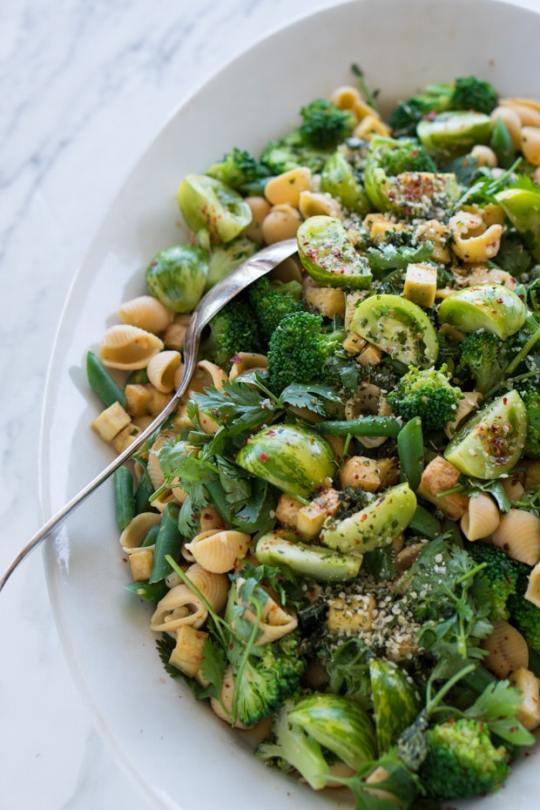
14. Walnut Strozzapreti -
Inspired by Mona Talbott's recipe in the new Coco cookbook, a pounded walnut pesto with marjoram and parsley, tossedwith farro pasta and Pecorino cheese. Get the recipe here.
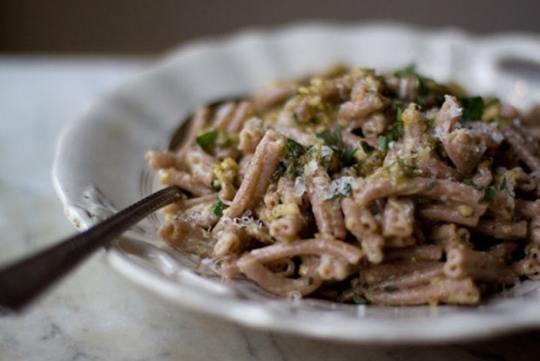
15. 10 Minute Instant Pot Mushroom Broth -
You can use this Instant Pot mushroom broth a thousand different ways. If you have dried porcini mushrooms, a few cloves of garlic, salt, pepper, and a bit of thyme, you're in business. This broth, your favorite pasta, and whatever toppings you have on hand make an A+ on-the-fly meal! Get the recipe here.

16. Quick Shredded Tofu Stir-fry -
This is a snappy little stir-fry, it comes together in a flash, and is the perfect way to kick off the new year. Use it as a spring roll or lettuce wrap filling as well! Get the recipe here.

17. Orange Pan-glazed Tempeh -
This is a snappy little stir-fry, it comes together in a flash, and is the perfect way to kick off the new year. Use it as a spring roll or lettuce wrap filling as well! Get the recipe here.

Also, browse this list of dinner ideas. There are so many favorite recipes worth making in that list. Not all are as quick as those on this page, but you'll find some gems there!
Share this...
Pinterest
0Facebook
0Google+
0email

WEEKNIGHT EXPRESS features 10 Vegetarian, Plant-centric Recipes for Feel-Good Food — Fast!
Subscribe to get 32-pages of recipes to view on your tablet, e-book reader or phone.



Follow Me:
Instagram
Youtube
Facebook
Pinterest
Related Recipes

40 Essential Instant Pot Links
All the helpful, essential Instant Pot links in one list. Links to accessories, videos, water test how-to, recipes, guides, etc.

Quick Vegan Enchiladas with Sweet Potato Sauce
These vegan enchiladas are knock-out delicious, in the oven in less that ten minutes, and a healthful alternative to all the heavy cheese versions out there. With black beans, sweet potatoes, and a stealthy turmeric boost.
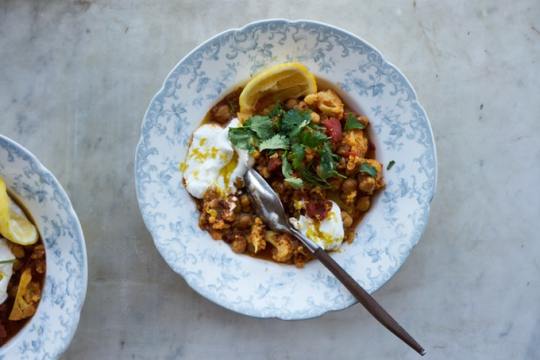
Instant Pot Chickpea Cauliflower Korma
An Insta-friendly riff on the Chickpea Cauliflower Korma recipe in Jennifer Iserloh's The Healing Slow Cooker - chickpeas, cauliflower, combined with a not-shy simmer sauce.
More Recipes
Whole Grain
WFPB
Vegetarian
Vegan
Soups
Side Dishes
Sandwiches
Salads
Pasta
Quick
Main Course
Low Carb
Instant Pot
Holiday
High Protein
Gluten Free
Drinks
Dinner Ideas
Desserts
Cookies
Chocolate
Breakfast
Baking
Appetizers

Follow Me:
Instagram
Youtube
Facebook
Pinterest
Popular Ingredients
avocado
egg
herb
kale
lemon
lentil
quinoa
pasta
tomato
turmeric
yogurt
zucchini
arugula
asparagus
basil
broccoli
buttermilk
cauliflower
chickpea
chocolate
curry
tempeh
tofu
ALL
© 101 Cookbooks 2019
Use of this site constitutes acceptance of its User Agreement and Privacy Policy.

Source: https://www.101cookbooks.com/17-of-the-easiest-dinners/
0 notes
Text
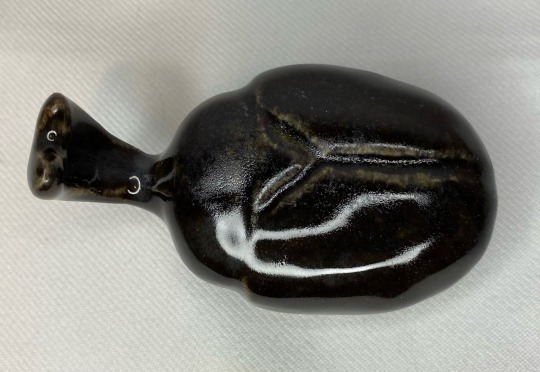
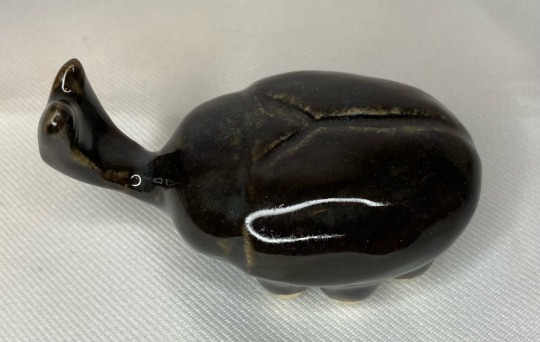


2021 and 2022 I mostly made mushrooms out of leftover clay. I think 2023 I'll make more beetles. I use my little dudes to test glaze combos. I think the green over the red turned out really cool. (if you're a potter and want to know the actual combination of Amaco glazes, send me a message, I write all that shit down)
3K notes
·
View notes
Text
The Food Hall Features Exclusive Burgers and Culinary Creations by Chef Carlo Miguel
The Food Hall at SM Aura Premier is bringing out some never-before-seen culinary creations courtesy of FooDee Global Concepts Corporate Executive Chef Carlo Miguel. Over the past few months, The Food Hall has served as Chef Carlo’s test kitchen where he stretches the limits of his culinary imagination to create new exciting dishes for the FooDee group of restaurants. Diners can get first dibs on these signature dishes whenever they visit this elegant food hall.
You can find The Food Hall at the 5th Level Skypark of SM Aura Premier in Bonifacio Global City. This is a chef-curated dining concept offering a whole range of cuisines from the FooDee Global group including Pound, Flatterie, Hook, and The Grill. It was formerly known as Todd English Food Hall but with Chef Carlo now at the helm, the restaurant is venturing into another new exciting chapter.
There are several seating areas inside The Food Hall depending on your mood. Hungry guests should head straight to The Grill Room or Pound dining areas which is more suited for lunch or dinner periods. All orders are centralized and there is only one menu for all the restaurants, so it is not like a typical food park where you have to order individually at each restaurant. Depending on the dishes that you order, you can see them being prepared at the open kitchens of their respective brands.
If you are just here for some coffee or tea, the area nearest the entrance is your best location with its bright and casual ambiance.
You can also hang out at the bar area if those are the beverages you prefer. The Food Hall is a great venue for corporate events and special occasions as their function hall can fit up to 250 guests with menus that can be customized to suit the client’s needs.
Chef Carlo Miguel is acknowledged in the local culinary scene as a master of premium and innovative burger creations. When he took over at Pound, I really noticed the improvement in their line of premium burgers. He has also come up with a host of new creations from seafood, steaks, flatbreads, pasta, and desserts which are on full display exclusively at The Food Hall. Lucky us, we’re going to be one of the first to try them.
Let’s start with the Burger Exclusives from Pound that can only be found here at The Food Hall. The Bacon Cheeseburger (P295) comes with house ground patty, American cheese, caramelized onions, and a grilled bacon secret sauce that really spells the difference.
Cheese lovers should try the Truffle Blue Cheese Burger (P365) which has a 1/3-pound steak cut all beef patty topped with Gorgonzola cheese, caramelized onions and truffle aioli. There’s also another cheesy option in the Molten Cheese Burger (P355) which is topped with a molten cheese blend, lettuce, tomato, and mustard relish.
Another specialty is the Double Smash Burger (P365) which comes with two 2oz. all-beef smashed patties wrapped inside a cheddar cheese crust with homemade bacon jam and a secret sauce. The crunchy texture of the patties make this a truly unique burger experience.
If you want even more meat, go for the Wagyu Brisket Burger (P395). This has a 1/3-pound steak cut beef patty topped with a 36-hour sous vide Wagyu beef brisket, American cheese, grilled onions and homemade BBQ sauce. Beef on beef really sounds good to me.
If you can’t decide between seafood or burgers, then the Surf & Turf Burger (P385) is your heavenly answer. It has a 1/3-pound all beef patty that comes with crispy shrimp poppers, mozzarella cheese, Thai sweet chili and cilantro cream.
The Fig & Foie Burger (P645) is an upgraded version of the Foie Gras Burger I love at Pound. Aside from the succulent seared foie gras, this one comes with brie cheese, balsamic figs, and mustard relish. The sweet figs heighten the flavors of the foie gras even further which all blends well together with the very juicy burger patty.
But the main attraction that afternoon would have to be The Kitchen Sink Burger (P595). Excalibur comes to mind as this humongous burger comes with everything maybe even including the kitchen sink. Somewhere inside this behemoth is wagyu brisket, pork carnitas, bacon slab, three kinds of onions and American cheese. Finish all that and you deserve to be called a king.
It’s not just burgers at The Food Hall because Flatterie also has some new pasta dishes to explore. The Creamy Sausage & Mushroom Pasta (P365) has campanelle pasta in a creamy Italian sausage and mushroom sauce. This plate is good for sharing so you can enjoy it with the entire table.
They also have the Seafood Pasta (P495) which has squid ink spaghetti together with shrimp, squid, clams, mussels, chili, lemon, and olive oil.
The Grill is FooDee Global’s own concept which can only be found at The Food Hall. It offers barbecued specialties such as the Miso Glazed Hamachi Collar (P565) with its chargrilled and miso glazed hamachi that comes with miso eggplant and steamed rice. This serving is good for two persons.
Another new item is the BBQ Pork Belly with chimichurri and pickles. This one has a very tender sous vide Spanish pork belly complemented by salsa verde, pickled onion, cucumber, and fresh cilantro.
Filipinos love fried chicken so the Juicy Fried Chicken Basket (P445) will always be a popular choice. These crispy buttermilk fried chicken are served with homemade butter and corn muffins plus french fries. They also come with gravy and honey syrup.
Thanksgiving is fast approaching so Chef Carlo has created a special 2-part Roast Turkey dish for the season. This white meat and dark meat turkey steak combination is doused in peppercorn gravy with cranberry relish and pumpkin puree.
The Beef Cheek Rendang (P495) is Chef Carlo’s version of the popular Southeast Asian dish. The slow braised beef cheek is cooked in coconut milk and Asian spices then served with rice and shrimp krupuk.
For meat lovers like me, the Wagyu BBQ Brisket Platter (P990) is the best dish to order. It comes with 36-hour Sous Vide Wagyu beef brisket, a half rack of BBQ ribs, house coleslaw, and French fries. I would probably order a cup of rice as well to complete the carnivorous feast.
For desserts, the White Chocolate Raspberry Crème Brulee (P220) is a fantastic option. Break open its crusty caramelized top and you will arrive at the soft and sweet crème brulee at the bottom.
The Dark Chocolate Soufflé (P320) is also a nice chocolatey treat. Pour the salted caramel sauce inside the warm soufflé and eat it together with the Vanilla ice cream. The Sticky Date Pudding is another hot and cold combination with Vanilla ice cream on top of sweet caramel pudding.
I would like to thank Chef Carlo Miguel for hosting our lunch at The Food Hall and showing us some of his newest culinary creations. I really love what he has done with the FooDee Global restaurants and I’m always happy to see what new adventures he has been cooking. Visit The Food Hall in SM Aura and see these mouthwatering dishes for yourself.
The Food Hall
5/F Skypark, SM Aura Premier, McKinley Parkway, Taguig
(0917) 863-3364
www.facebook.com/thefoodhallph
0 notes
Photo

New Post has been published on https://jmuo.com/for-a-killer-thanksgiving-vegetarian-main-dish-st/
For a Killer Thanksgiving Vegetarian Main Dish, St...
amzn_assoc_placement = "adunit0"; amzn_assoc_tracking_id = "fresh17-20"; amzn_assoc_ad_mode = "search"; amzn_assoc_ad_type = "smart"; amzn_assoc_marketplace = "amazon"; amzn_assoc_region = "US"; amzn_assoc_title = "Shop Related Products"; amzn_assoc_default_search_phrase = "cooking"; amzn_assoc_default_category = "Kitchen"; amzn_assoc_linkid = "51fe4d035c7af8dc5928e6f5e5b79c4e"; amzn_assoc_default_browse_node = "284507"; amzn_assoc_rows = "4"; amzn_assoc_design = "text_links";
[Photographs: Vicky Wasik]
More
All About Cheese
Everything you need to know about eating and cooking with curds
We all know what to expect each year at Thanksgiving. There are logistical headaches, including the annual game of fridge-space Jenga and the monumental task of trying to serve a lot of hot food to a lot of people, all at the same time. As for the food itself, there will be stuffing, gravy, cranberry sauce, the turkey, pie, and the inevitable appearance of that “signature side” some twice-removed cousin always brings, even though you diplomatically twice-reminded them that they really didn’t need to go to the trouble this year.
One thing that can’t be counted on for Thanksgiving dinner—a vegetarian centerpiece. Most vegetarians are experienced at cobbling together a holiday meal of side dishes, which isn’t awful, but it often means forgoing the best items on the menu (stuffing, a gravy moat for mashed potatoes, the iconic turkey). Dinner can end up feeling like an afterthought.
Attempts at inclusivity in the form of tofurkey are a lot like your uncle’s conversational use of “lit” and “AF”—well intentioned, but painfully out of touch. To be fair, pulling off a vegetarian alternative to a large roast of meat is no simple task.
For one, there aren’t many vegetables that have the scale to be presentation-piece-worthy on their own. And, while whole roasted heads of cauliflower are definitely having a moment, they aren’t exactly holiday comfort food. Forcing a like-for-like vegetable-as-meat parallel isn’t the answer.
Instead, we can embrace the sides-as-main-course angle and just put a bit more thought into it to come up with a cohesive and satisfying dish. By using ingredients that most people already have on hand for Thanksgiving dinner, I was able to come up with a well-considered vegetarian main course that’s not only a complete thought but also a dinner-table stunner. Behold: the stuffed roast pumpkin.
Stuffed pumpkins are one of the few made-for-Pinterest foods that are as tasty as they are adorable. They’re classic cold-weather comfort food, a genre that the French have on lock (cassoulet, anyone?).
In France, this dish is commonly made using a squash varietal called potimarron, which gets its name from a combination of the French terms for “pumpkin” (potiron) and “chestnut” (marron). This squash is known as red kuri here in the States, borrowing the Japanese word for “chestnut” (kuri).
As these names suggest, kuri squash takes on a rich, nutty flavor when roasted. Potimarron farci (stuffed kuri squash) can be filled with any number of ingredients, beginning with a hearty base ingredient like lentils, rice, or grains. My favorite version uses pieces of dried bread as a foundation, saturating them in cream, cheese, and herbs to make a savory bread pudding, in a pumpkin. Traditional recipes load up the hollow gourd with salty pork parts, but to make this vegetarian, I obviously left those out.
My mission was to create a vegetarian stuffed pumpkin that felt even more at home on the Thanksgiving table. I wanted to create a main course that delivered all those classic autumnal flavors, while also providing the visual wow factor of a holiday roast.
I started by using sugar pumpkins instead of red kuri squash, since they’re more widely available in the United States (plus, they deliver a true jack-o’-lantern look), but then added a kabocha squash purée to the filling, which introduces a nutty flavor similar to that of the red kuri squash.
I also replaced the salty pork with sautéed shiitake mushrooms and lacinato kale, sprinkling in toasted pepitas and pecans for a nutty crunch. A generous amount of warm-spiced heavy cream and Gruyère cheese should lay to rest any concerns that going vegetarian has to mean compromising richness.
All of these components get layered into the pumpkins, which I paint with a salty-sweet miso-honey glaze before roasting. Yup, you can eat the whole thing, skin and all. I’m not always one for foods acting as cooking or serving vessels (big fan of the We Want Plates subreddit right here), but this is no chowder in a sourdough-bread bowl; this is a Thanksgiving stuffed pumpkin to make the turkey-eaters jealous.
Bake What Your Menu Gave You
Before we embark on this roasted-pumpkin journey together, I want to make clear that this recipe is not meant to be rigidly prescriptive. Like cassoulet, this dish has humble roots, and, as Kenji pointed out in his treatise on French stewed beans and meats, it’s the kind of recipe that is designed to make do with what is available.
For our purposes, that means filling your pumpkins with whatever you’ve already got for the rest of your Thanksgiving menu. This is a stressful enough meal to execute as it is, so there’s no need to make your life harder just for the sake of a recipe.
Already have bread cubed up and dried out for stuffing? Use that. Don’t have shiitakes, but you did buy a ton of creminis for a stuffed-mushroom hors d’oeuvre? Awesome, those will work just fine. Have more mashed sweet potatoes than you need for that casserole? Sub them in for the kabocha purée in this recipe; nobody will know, or judge.
Oh, and one final thing—if you have only a couple vegetarians coming over to dinner, you should absolutely stuff the extra pumpkins in this recipe with bacon or sausage, or both. Just make sure to mark them in some way, or Thanksgiving dinner could get even more uncomfortable than usual (and that’s saying something).
Before You Begin: Pick Your Pumpkins
One ingredient you will need to get is pumpkins. No, you can’t repurpose the rotting jack-o’-lantern that’s been sitting on your front stoop since October. Sorry. What you’re looking for are small “sugar pumpkins” that roast up creamy-fleshed and sweet (truth in advertising!). As with all winter squash, pick pumpkins that are mostly blemish-free, with no visible bruising, soft spots, or mold.
A common refrain calls for choosing specimens that “feel heavy for their size” when you’re selecting squash. I’m not sure I lift enough squash in my life to know exactly what that means, and certainly don’t condone pumpkin body-shaming, but in this case, you’re looking for four sugar pumpkins, and one kabocha squash, that all weigh around two pounds each. (Of course, you can double or triple or even halve this recipe, if desired.)
How to Make Thanksgiving Vegetarian Stuffed Pumpkins
Step 1: Prepare and Par-Roast the Squashes
Once you have your pumpkins, it’s time to get to work, starting with all of the squash. First, halve the kabocha, and use a spoon to scrape out the seeds and stringy pulp.
Next, prepare the sugar pumpkins. It’s just like prepping a bunch of mini jack-o’-lanterns—use a paring knife to take their tops off, then go in with a spoon to perform the same seeds-and-pulp surgery. Make sure to clean the undersides of the tops as well (again, a paring knife gets the job done quickly), and try to avoid the temptation to carve a face.
Now, let’s talk squash seasoning. While we’ll be stuffing the pumpkins with plenty of savory goodies, it’s important to properly season the pumpkins themselves. In early rounds of recipe testing, I took a light approach with salt and pepper on the pumpkins, and it made for an uneven dish, as the muted flavor of the pumpkin clashed with the confident seasoning of the filling.
I hate eating at restaurants where dishes come with instructions telling you, “In order to enjoy this properly, make sure you get a bit of everything in each bite.” Food shouldn’t require a user manual; every component of a dish should be well calibrated for seasoning.
In this case, that means drizzling and rubbing the flesh of the pumpkins and kabocha with olive oil before seasoning them assertively with kosher salt and freshly ground black pepper. The oil provides not only fat and flavor but also a more adhesive surface for the salt and pepper to cling to.
I arrange all the squashes on a parchment-lined rimmed baking sheet and pop them in the oven to roast for about an hour, until the kabocha is tender and the pumpkins have just begun to soften. Once they come out of the oven, I set the baking sheet aside to cool, removing the tops of the pumpkins to allow steam to escape.
Par-roasting the pumpkins before stuffing them not only speeds up the final baking time on the back end of the recipe, but also ensures that the finished stuffed squashes are perfectly cooked inside and out. That’s especially important given that the pumpkins’ flesh requires a longer cooking time than the stuffing ingredients, many of which are already cooked prior to roasting. While the squashes are in the oven, there’s plenty of time to put together the other components for the filling.
Once the kabocha is cool enough to handle, scoop out the flesh and roughly mash it in a bowl with a large spoon. Season it with salt and pepper, then set it aside.
Step 2: Cook the Mushrooms and Kale
While the pumpkins are par-roasting, I turn my attention to sautéing the mushrooms and kale. I start by heating a couple of tablespoons of oil in a 12-inch skillet until shimmering, then add a full pound of thinly sliced shiitake mushroom caps. At first, this may look like a ton of mushrooms overcrowding the skillet, but don’t sweat it—let the shiitakes do all the sweating.
They’ll soon cook down, releasing water, and once that’s happened, they’ll begin browning. Make sure to actually let them get some good color. You don’t want to rush things and end up with a sad pile of steamed mushrooms. If your skillet gets too dry and begins to smoke, you can always add a touch more oil and reduce the heat a bit.
Once the shiitakes are golden brown, I push them to the outer edges of the skillet and add the kale. Again, what initially seems like an overcrowded skillet will soon be much more manageable as the kale wilts down. We aren’t looking to fully cook the lacinato here, just wilt it slightly, as we still want it to have a little texture and bite in the end. (Lacinato kale is much sturdier than the curly stuff, and therefore better suited for this recipe.)
I repeat the process of pushing everything to the outer edges of the skillet, then add a few tablespoons of butter to its now-empty center. Once the butter melts and begins to foam, I add minced shallots, garlic, and chopped fresh thyme, then stir constantly for a few seconds, just until I’m hit with the sweet smell of alliums and the woodsy aroma of crackling thyme. I finish the mushrooms with some sherry, plus a touch of sherry vinegar for acidity.
Step 3: Whisk Together the Spiced Cream
As I mentioned in the beginning, this filling is essentially a savory bread pudding, and that means we need some creamy liquid to moisten and bind everything together. While there aren’t any eggs in the recipe, I do use plenty of cream, cut with a little whole milk and seasoned with plenty of warm spices, including cinnamon, nutmeg, ginger, and clove.
Step 4: Layer the Stuffing
Gather together the rest of the stuffing mise en place: cubed and dried bread, shredded Gruyère, and the toasted pepitas and pecans. It’s time to load those pumpkins up.
First things first—we’ll be layering all of the components inside the pumpkins, twice. Keep that in mind as you begin dividing the ingredients between the pumpkins. I layer everything in the following order: a large spoonful of the mashed kabocha, a small handful of bread pieces, then some of the mushroom-kale mixture, followed by the pepitas and pecans, and then a showering of Gruyère.
To finish off the first layer, I pour half of the cream mixture into the four pumpkins, then use my hands to gently press everything down and evenly saturate the ingredients with the spiced cream.
Repeat this layering process once more, making sure there’s a good amount of Gruyère peeking up over the rims of the pumpkins, so it can get gooey and melty in the oven.
Depending on the size of your pumpkins, you may have some leftover filling ingredients. I’m of the mindset that for a project like this it’s always better to have a little extra than not enough. If you have enough stuff left over, you can always put everything in some small ramekins and bake them, sans pumpkin.
Step 5: Glaze the Pumpkins
Since the goal is for every bite to be well seasoned, that means we have to give the pumpkin skins some attention. If we’re willing to spend the time tending to the delicious, burnished, crispy skin of a Thanksgiving turkey, then pumpkin skins should be afforded the same care and consideration, and here that means a glaze.
I wanted to make sure that glazing the pumpkins wouldn’t make them too sweet, as I’m not a fan of dishes that are billed as “savory” but then pile more sugar onto the natural sweetness of squash. We’re trying to make a main course, not dessert. I decided on a simple mixture of red miso, honey, and a little bit of water—the salty funk of miso pairs really well with root vegetables, while the honey balances out that salinity and provides subtle, floral sweetness that isn’t overbearing.
After whisking this mixture together, I use a pastry brush to paint the glaze on the pumpkins. This step, I want to stress, is totally optional. If you don’t have miso kicking around in your fridge, don’t worry about it. The pumpkins will be delicious, glazed or not.
Step 6: The Final Roast
We’re now in the home stretch. Place your pumpkins back on that parchment-lined baking sheet, and roast them, without their tops, until that top layer of Gruyère is melted and lightly browned and the pumpkins are fully tender. (Use a paring knife to check them; the blade should be able to pierce the pumpkins with little resistance.)
Open the oven, replace the tops on your gourds, and bake them a few more minutes to make sure every bit of pumpkin is heated through. If you’re at all worried, you can always use an instant-read thermometer to double-check that everything is hot (at least 150°F/66°C in the center).
Take them out of the oven and let them cool for a few minutes, until the cream settles down a bit. All you have to do now is carefully transfer them to a serving platter and portion them out as you see fit. You can either carve them up with a knife and pop a serving spoon in each one for cheese-pull scooping, or, if you have some famished vegetarians on your hands, just serve them individually. One pumpkin should be more than enough for two people, but it’s Thanksgiving. Unbuckle that belt, and do you.
This post may contain links to Amazon or other partners; your purchases via these links can benefit Serious Eats. Read more about our affiliate linking policy.
amzn_assoc_placement = "adunit0"; amzn_assoc_search_bar = "true"; amzn_assoc_search_bar_position = "bottom"; amzn_assoc_tracking_id = "fresh17-20"; amzn_assoc_ad_mode = "search"; amzn_assoc_ad_type = "smart"; amzn_assoc_marketplace = "amazon"; amzn_assoc_region = "US"; amzn_assoc_title = "Shop Related Products"; amzn_assoc_default_search_phrase = "cookware"; amzn_assoc_default_category = "All"; amzn_assoc_linkid = "b45319dac495d29e17b5eff312392025";
Source link
0 notes